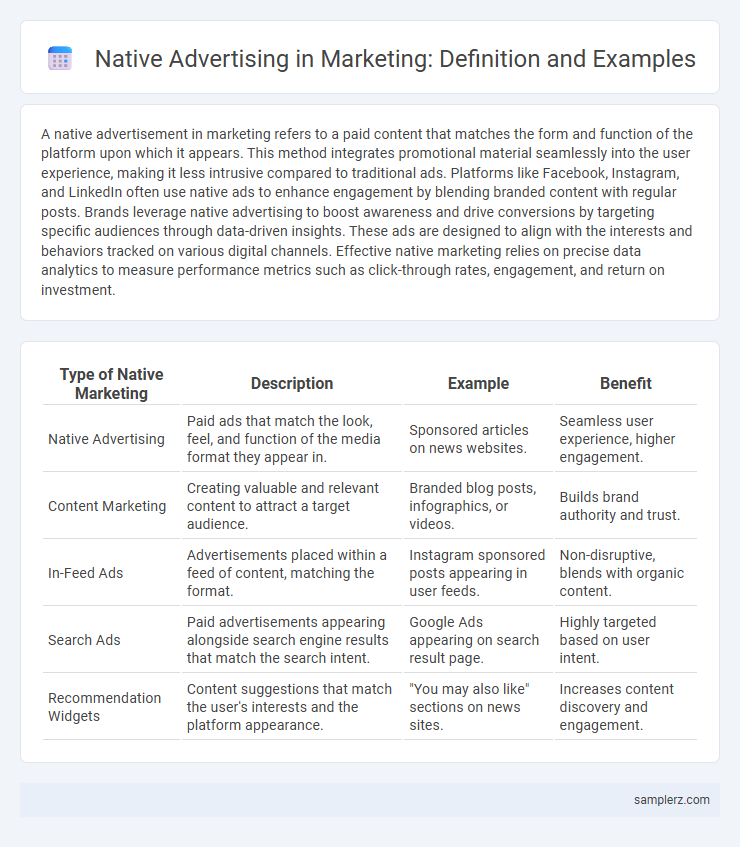A native advertisement in marketing refers to a paid content that matches the form and function of the platform upon which it appears. This method integrates promotional material seamlessly into the user experience, making it less intrusive compared to traditional ads. Platforms like Facebook, Instagram, and LinkedIn often use native ads to enhance engagement by blending branded content with regular posts. Brands leverage native advertising to boost awareness and drive conversions by targeting specific audiences through data-driven insights. These ads are designed to align with the interests and behaviors tracked on various digital channels. Effective native marketing relies on precise data analytics to measure performance metrics such as click-through rates, engagement, and return on investment.
Table of Comparison
| Type of Native Marketing | Description | Example | Benefit |
|---|---|---|---|
| Native Advertising | Paid ads that match the look, feel, and function of the media format they appear in. | Sponsored articles on news websites. | Seamless user experience, higher engagement. |
| Content Marketing | Creating valuable and relevant content to attract a target audience. | Branded blog posts, infographics, or videos. | Builds brand authority and trust. |
| In-Feed Ads | Advertisements placed within a feed of content, matching the format. | Instagram sponsored posts appearing in user feeds. | Non-disruptive, blends with organic content. |
| Search Ads | Paid advertisements appearing alongside search engine results that match the search intent. | Google Ads appearing on search result page. | Highly targeted based on user intent. |
| Recommendation Widgets | Content suggestions that match the user's interests and the platform appearance. | "You may also like" sections on news sites. | Increases content discovery and engagement. |
What Is Native Marketing?
Native marketing seamlessly integrates promotional content within the user experience by matching the form and function of the platform on which it appears. Examples include sponsored articles on news websites, promoted posts on social media, and in-feed ads on mobile apps that mimic organic content. This strategy enhances user engagement by delivering value without disrupting browsing flow, increasing conversion rates and brand trust.
Key Characteristics of Native Marketing
Native marketing seamlessly integrates promotional content within the natural flow of a platform, matching the form and function of the surrounding media. Key characteristics include non-disruptive placement, relevance to the audience, and alignment with the platform's style and tone to enhance user engagement. This approach fosters authenticity and trust, leading to higher click-through rates and improved brand perception.
Benefits of Using Native Marketing Tactics
Native marketing tactics seamlessly integrate branded content within relevant platforms, enhancing user experience by avoiding disruptive ads and increasing engagement rates by up to 60%. These strategies build trust and brand credibility, leading to higher conversion rates compared to traditional advertising methods. Leveraging native marketing drives better customer retention and nurtures organic growth across social media, blogs, and other digital channels.
Native Advertising vs. Traditional Advertising
Native advertising integrates promotional content seamlessly within the user experience, appearing as natural parts of the platform, such as sponsored articles on news websites or recommended content on social media feeds. Traditional advertising, including banners, TV commercials, and pop-up ads, distinctly separates promotional messages from editorial content, often interrupting the user experience. Studies show native ads achieve higher engagement rates, with a 52% increase in purchase intent compared to traditional ads, due to their less intrusive and more relevant presentation.
Successful Examples of Native Marketing Campaigns
Coca-Cola's "Share a Coke" campaign personalized bottles with popular names, driving social media engagement and a 2% increase in U.S. sales. Spotify's "Wrapped" feature delivered personalized year-end listening summaries, boosting user retention and generating millions of shares across platforms. Airbnb's "Live There" campaign used native storytelling to immerse users in authentic travel experiences, increasing bookings by 30% in targeted markets.
Platforms for Implementing Native Marketing
Platforms for implementing native marketing include social media sites like Facebook, Instagram, and Twitter, where sponsored posts blend seamlessly with user-generated content. Content recommendation networks such as Taboola and Outbrain integrate promoted articles within editorial streams, enhancing engagement without disrupting user experience. Programmatic advertising platforms like Sharethrough and TripleLift enable automated delivery of native ads across diverse publisher sites, optimizing reach and relevance.
Best Practices for Native Content Creation
Effective native marketing integrates brand messages seamlessly within platform-specific content, ensuring alignment with audience preferences and consumption habits. Best practices for native content creation include thorough audience research, leveraging storytelling that resonates emotionally, and maintaining consistent brand voice without disrupting user experience. High-performing native ads prioritize authenticity, context relevance, and subtle promotional elements, driving engagement and conversion rates while respecting platform guidelines.
Measuring the Effectiveness of Native Marketing
Measuring the effectiveness of native marketing involves analyzing key metrics such as engagement rates, click-through rates, and conversion rates to determine how well the content resonates with the target audience. Tools like Google Analytics and social media insights provide valuable data on user behavior and interaction with native ads. Tracking brand lift studies and sentiment analysis further helps in assessing the impact on brand awareness and consumer perception.
Ethical Considerations in Native Marketing
Native marketing involves seamlessly integrating promotional content into platforms without disrupting user experience. Ethical considerations emphasize transparency, requiring clear disclosure that content is sponsored to maintain consumer trust and prevent deceptive practices. Marketers must also respect user privacy by avoiding intrusive data collection and ensuring content relevance aligns with audience expectations.
Future Trends in Native Marketing
Native marketing is evolving with advanced AI-driven content personalization and immersive augmented reality experiences that seamlessly integrate brands into user environments. Predictive analytics and machine learning models enable hyper-targeted campaigns, enhancing user engagement and conversion rates. Voice search optimization and shoppable native ads are emerging as key future trends, transforming consumer interactions within digital ecosystems.

example of native in marketing Infographic
 samplerz.com
samplerz.com